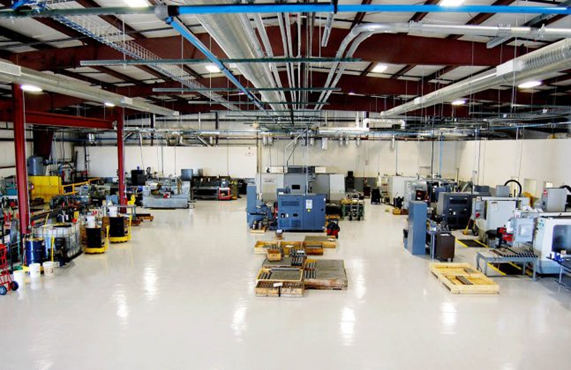Numerous obstacles affect the flooring industry’s operations and expansion. Price fluctuations for raw materials like vinyl, laminate, and wood can significantly disrupt pricing plans and manufacturing budgets. Another obstacle is the highly competitive flooring market, where multiple companies are contending for clients’ attention while offering a wide variety of flooring options, making it more challenging for certain brands to make their mark.
Many leading players in the flooring market must also cope with shifting consumer demands and preferences, such as market growth drivers for sustainable and eco-friendly flooring materials. For flooring companies, installation complications, such as the need for experienced workers and training, add to the situation’s complexity. Although technology provides novel solutions, it requires constant investment and adaptation to remain competitive.
3 Best Flooring Solutions for Global Flooring Needs
Epoxy Resin Flooring
Epoxy resin flooring is a strong and versatile choice for many areas. It provides a robust, chemical-proof covering with an appropriate hardening agent, making it suitable resilient flooring for areas with heavy traffic, like workshops or workplaces. It protects the surface from damage, marks, and scars like a substantial obstacle.
It’s also adjustable to coordinate with different design preferences and is available in shades and textures. Epoxy resin flooring is a common choice in the flooring industry because the material is more easily wiped down and managed. It is a durable floor with a pleasing appearance.
Polyurethane Flooring
Polyurethane flooring is a robust and adaptable choice that is frequently utilized in a variety of contexts. Comparable to flexible armour for your floors, it provides resilience and Armstrong flooring. Despite its popularity as resistant to marks, chemical substances, and scratches, this type of floor covering is perfect for sites with abundant pedestrian traffic or encounters with abrasive elements.
It is commonly utilized for commercial locations such as arenas for sports and houses where simple care and endurance are primary priorities. Polyurethane flooring can be modified according to particular architectural preferences due to its different coatings, which include shiny and satin. It is an efficient and popular alternative in the construction industry due to its effortless setup and stability.
Anti-slip flooring
Anti-slip flooring has a layer of texture that enhances grip and reduces the possibility of getting hurt. You have a firm grasp on the floor, especially around moist areas. This laying is often used in regions susceptible to potentially treacherous conditions, such as toilets, cooking, and exterior areas.
Several ways to achieve a textured surface include applying speciality coatings or adding particles. Anti-slip flooring is crucial for safety, particularly in businesses where many people walk about. Reducing accidents and making everyone’s surroundings safer is a sensible decision.
Challenges in the flooring industry
The flooring industry faces many challenges that impact its operations, growth, and ability to meet customer demands effectively. Understanding and navigating these flooring market company challenges is essential for companies in the flooring industry to remain competitive, innovative, and sustainable in a dynamic market landscape.
Price fluctuation of flooring materials
Changes in raw material prices are akin to a rollercoaster ride for the flooring sector. Imagine if vinyl, laminate, or wood flooring were reasonably priced one month, and then suddenly, the next month, the prices skyrocketed. This volatility throws production schedules for a loop and makes determining a fair price for customers challenging.
Businesses must constantly modify their budgets and strategies for these extreme fluctuations. It resembles attempting to manage a rough, unpredictable, and stormy sea. These variations can affect every aspect of the supply chain, ranging from retail prices to production costs. Flooring companies must be adaptable and closely monitor these patterns to weather these ups and downs without going bankrupt.
Lack of training
One major obstacle in the flooring sector is the need for more training. Imagine a need for more knowledgeable workers adept at installing various types of flooring. For businesses attempting to complete projects accurately and on schedule, this shortfall causes a great deal of stress.
Lack of instruction can increase the probability of mistakes, resulting in expensive repairs and disappointing customers. Similar to attempting to construct a house without a strong foundation, things can quickly become unstable.
Furthermore, because technology is constantly changing, workers are becoming increasingly dependent on staying up to date on the newest methods and resources. This training disparity hinders the industry’s capacity to innovate and adjust, lowering the calibre of work.
Supply and stock shortages
In the flooring business, shortages of both supplies and inventory can be problematic. Imagine the possibility that you run an organization and try to meet demands, but you need more supplies in stock to accomplish this.
Plenty of options may lead to this limited availability, involving delays in manufacturing, sudden increases in demand, and supply network disturbances. It interrupts the entire procedure, like when you attempt to prepare a birthday cake and find you lack a vital ingredient in the middle.
Insufficient supply can cause delays in project completion schedules, angry clients, and lost commercial prospects. Furthermore, inventory management becomes even more critical as new flooring options are introduced and the industry changes.
Competitive Marketplace
The flooring industry reflects a saturated environment where enterprises compete for client attention. Imagine a busy road surrounded by stores providing a variety of floor alternatives: floor coverings, laminated flooring, lumber—you choose anything. It is difficult for one company to stand out in this crowded market.
To gain market share, businesses must continuously innovate by providing distinctive designs, environmentally responsible solutions, or top-notch customer service. It’s comparable to a game of chess in which every move matters, and maintaining an advantage calls for cunning.
Price wars can also occur when businesses cut their prices to attract clients. This can reduce profit margins and lead to a race to the bottom. Furthermore, as internet shopping grows, there is now worldwide competition instead of simply local.
Inappropriate raw materials
Dealing with improper materials may be a significant pain in the flooring sector. Consider yourself a consumer searching for a long-lasting, sturdy flooring solution, only to receive a product that prematurely shows wear and tear symptoms.
This can occur when businesses employ inferior materials in their production processes or when they advertise their products incorrectly. Imagine purchasing a car touted with excellent performance only to discover it has trouble starting.
These items only benefit the industry’s overall reputation and make customers dissatisfied. Furthermore, as consumers value sustainability and environmental friendliness more, companies that still need to fulfil these requirements risk criticism. Businesses must guarantee that their products meet quality standards and be open about them.
Lack of experienced worker
The need for more competent workers is one of the main issues facing the flooring sector. Imagine finding it challenging to find skilled professionals who can install various types of flooring with accuracy and efficiency. This shortage could lead to project delays, decreased work quality, and higher rework costs.
It won’t be easy, like trying to build a house with a team that has never raised a hammer. Businesses usually have to make tough choices, such as hiring less experienced workers and investing more in training or higher remuneration, to attract talent because they need more experienced individuals.
Disposal of waste
In the flooring sector, trash disposal is a critical yet tricky task. Consider all the items left over after the flooring is installed. Fragments of wood, worn-out rugs, and packing materials quickly pile up. It’s similar to tidying up after a significant building project—more frequent. Poor disposal practices can exacerbate landfill difficulties and cause pollution and other environmental problems.
For this reason, businesses require efficient waste management plans. Reproducing and recycling products helps reduce trash and minimize the adverse ecological effects of this industry. It is equivalent to reusing remnants from another meal instead of dumping them. However, waste management can be complex for smaller firms because it takes time, effort, and occasionally extra money.
FAQ’s
What are the primary obstacles that the flooring sector must overcome?
Changes in raw material prices, market competition, a shortage of trained workers, improper product handling, and waste disposal are the primary obstacles.
What effects do price changes have on the flooring industry in 2024?
Raw material price swings can cause havoc with supply chains, pricing plans, and production budgets, making it difficult for businesses to stay stable and profitable.
What effects does the flooring industry’s shortage of skilled workers have?
A shortage of experienced workers may delay projects, suffer from poor quality, cost more in reworks, and pose challenges in implementing new methods and technology.
What effects does the cutthroat industry have on flooring companies?
Organizations undergo stress to generate new ideas, establish themselves aside from rivals, and offer affordable rates in a highly saturated flooring products industry. This can occasionally result in price wars and reduced profit margins.
What environmental issues does the flooring sector need to deal with?
Sustainability and garbage disposal provide substantial hurdles since ineffective waste management practices can exacerbate landfill issues and contribute to environmental damage. As such, businesses must implement efficient waste management techniques.
Conclusion
There has been a great increase in the global flooring market size, and the flooring business is also confronting various difficulties, from unstable raw material prices and intense competition to a labour shortage and environmental issues. Industry-wide collaboration, creative solutions, and a proactive approach are needed to address these difficulties adequately. Businesses that can overcome these obstacles by making training investments, implementing sustainable practices, and remaining flexible in response to market developments will be better positioned to prosper in this ever-changing business environment.

